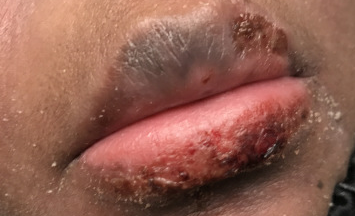A 44 y.o. woman with mixed connective tissue disease and renal failure on dialysis presents with a rash
The rash involves sloughing of the skin from the breasts, lips, perineum and inner thighs.
there are no lesions in the mouth. What is your differential?
Our pt is a 44 y.o. female with mixed connective tissue disease and renal failure. She is on dialysis and received a shunt revision 12/9. She reports a rash occurring two days after the shunt revision. The rash involves the lips, labia and skin diffusely with blistering.
The differential provided by dermatology was : Stevens Johnson syndrome, pemphigus ( or paraneoplastic pemphigus) ,hsv or DRESS.
A pt seen in the ED with pemphigus
Pemphigus can affect the lips and skin and is a bullous disease. It was included in the differential because it produces antibodies to proteins of keratinocyte adhesion. The word origin of pemphigus is the Greek word pemphix which means blister. Nikolsky’s sign is a common finding where pressure on a blister causes extension of the blister. A biopsy is diagnostic because there is deposition of IgG in the epithelial cells. In paraneoplastic pemphigus tumors induce autoantibodies to skin proteins this is can occur in malignant tumors and benign tumors like thymoma and Castleman’s disease. Immunoglobin is found in subepidermal regions not in the epidermis.
HSV- can cause blistering in the mouth or genitals and it can present with erythema multiforme. The skin biopsy of a herpetic lesion can be stained with antibodies to HSV antigen DNA polymerase proving that the lesion is herpetic. Patients with stem cell transplants are at risk for reactivation of herpes. The skin manifestations may be anywhere on a spectrum of erythema multiforme to toxic epidermal necrolysis.
DRESS- Drug reaction with eosinophilia and systemic symptoms is a rare drug-induced hypersensitivity reaction that presents with skin eruptions and organ involvement of the liver,kidney and lung. Our patient did not have eosinophilia or organ involvement. Reactivation of herpes virus occurs in up to 75% of cases.
Stevens Johnson syndrome- is a hypersensitivity reaction to a drug ( in the case of our patient a cephalosporin), a respiratory virus like mycoplasma or even a fungal infection. Medications known to lead to SJS are sulfa drugs, penicillins , lamaotrigine, Dilantin and rivaroxaban. The drug is usually administered within a month of the rash. Stevens Johnson syndrome is on a spectrum of dermal blistering with < 10% surface involvement. Toxic epidermal necrolysis on the other hand involves >30% of the skins surface. Risk factors for SJS include lupus and HIV.
Our patient had a skin biopsy consistent with SJS showing only lymphocytic invasion. She was unfortunately given a cephalosporin in the ED to cover for secondary infection which had most likely caused her SJS initially when she got a dose for her shunt revision. This was stopped and she was placed on steroids and recovered.
Santoro F, Stoopler E, Werth V. Pemphigus Dent Clin North Am. 2013. Oct;57(4)
Burnett J, Laing J, Aurelian L. Acute skin eruptions that are positive for herpes simplex virus DNA polymerase in patients with stem cell transplantation. Arch Dermatol. 2008 Jul;144(7):902-907.
Tohyama M, Hashimoto K, Yasukawa M, et al. Association of human herpesvirus 6 reactivation with the flaring and severity of drug-induced hypersensitivity syndrome. Br J Dermatol 2007;157:934.
Picard D, Janela B , Descamps V, et al. Drug reaction with eosinophilia and systemic symptoms: a multiorgan antiviral T cell response. Sci Transtl Med 2010;2:46ra62.




